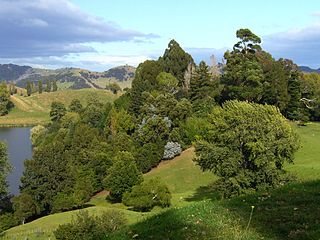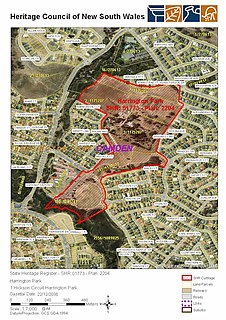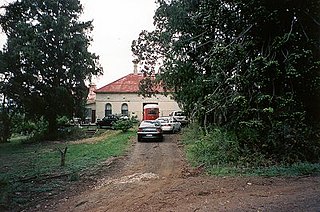
Wappinger, officially the Town of Wappinger, is a town in Dutchess County, New York, United States. The town is located in the Hudson River Valley region, approximately 65 miles (105 km) north of Midtown Manhattan, on the eastern bank of the Hudson River. The population was 27,048 at the 2010 census. The name is derived from the Wappinger Native Americans who inhabited the area. Wappinger comprises three-fourths of the incorporated Village of Wappingers Falls, several unincorporated hamlets such as Chelsea, Diddell, Hughsonville, Middlebush, Myers Corners, New Hackensack, and Swartwoutville, and a number of neighborhoods.

Fynbos is a small belt of natural shrubland or heathland vegetation located in the Western Cape and Eastern Cape provinces of South Africa. This area is predominantly coastal and mountainous, with a Mediterranean climate and rainy winters. The fynbos ecoregion is within the Mediterranean forests, woodlands, and scrub biome. In fields related to biogeography, fynbos is known for its exceptional degree of biodiversity and endemism, consisting about 80% species of the Cape floral kingdom where nearly 6,000 of them are endemic. This land continues to face severe human-caused threats, but due to the many economic uses of the fynbos, conservation efforts are being made to help restore it.

Vereeniging is a city located in the south of Gauteng province, South Africa, situated where the Klip River empties into the northern loop of the Vaal River. It is also one of the constituent parts of the Vaal Triangle region and was formerly situated in the Transvaal province. The name Vereeniging is derived from the Dutch word meaning "union".

Gansbaai is a fishing town and popular tourist destination in the Overberg District Municipality, Western Cape, South Africa. It is known for its dense population of great white sharks and as a whale-watching location.
"Sarie Marais" is a traditional South African folk song, created possibly during the First Anglo-Boer War or the Second Anglo-Boer War. The tune was possibly taken from a song dating back from the American Civil War called "Carry me back to Tennessee" or "Sweet Ellie Rhee" with the words roughly translated into Afrikaans.

Elgin is a large, lush area of land, circled by mountains, in the Overberg region of South Africa. This broad upland valley lies about 70 km southeast of Cape Town, just beyond the Hottentots Holland Mountains.

Caburgua Lake is located 23 km northeast of the city of Pucón, in the La Araucanía Region of Chile. Huerquehue National Park lies to the east of the lake. Like Villarrica Lake, it is part of Toltén River basin. During summer the outflow river may dry out but due to high levels of underground infiltration the waterfalls Ojos del Caburgua never run dry.

Many people of European heritage in South Africa are descended from Huguenots. Most of these originally settled in the Cape Colony, but were absorbed into the Afrikaner and Afrikaans-speaking population, because they had religious similarities to the Dutch colonists.

Hackfalls Arboretum is an arboretum in New Zealand. It was founded in the 1950s by Bob Berry. Hackfalls Arboretum is part of “Hackfalls Station”, a sheep and cattle farm of about 10 square kilometres, owned by the Berry family. Hackfalls is situated in Tiniroto, a tiny village in the eastern part of the North Island, between Gisborne (town) and Wairoa.
The area of the arboretum is 0.56 km2. It stretches along the borders of two lakes. It holds about 3,500 species of trees and shrubs. The collection contains many different oaks "spaced in rolling pastureland, allowing each to develop fully, and limbed up to enable grass to grow underneath". Most important part of the collection are about 50 different taxa of Mexican oaks.
The Langkloof is a 160 km long valley in South Africa, lying between Herold, a small village northeast of George, and The Heights - just beyond Twee Riviere.

Kenhardt is a small town in the Northern Cape province of South Africa. This little town is about 120 km from Upington, the largest town in the area.

Joubertina is a small town in the Kou-Kamma Local Municipality, Sarah Baartman District of the Eastern Cape province of South Africa.

Coenraad De Buys was described as "a remarkable figure" on the frontier of the Cape Colony. Travellers described him with awe. Their accounts mentioned that he was an impressive figure, nearly seven foot tall and with enormous self-confidence.

Sherwood Arboretum is a heritage-listed arboretum at 39A Turner Street, Sherwood, Queensland, Australia. A 1946 addition to the site is also known as the John Herbert Memorial Vista. It was added to the Queensland Heritage Register on 3 May 2007.
Skrijwershoek Arboretum is a private arboretum in Twee Riviere, South Africa. Though a private collection, on the campus of The South African Institute for Heritage Science and Conservation, the arboretum is nonetheless accessible to the interested public.

The South African Institute for Heritage Science and Conservation is a higher learning institution, founded in 1994. The Institute's faculty buildings and support facilities are situated on a 15-hectare campus in the village of Twee Riviere, in the Langkloof valley, adjacent to the Southern Cape Region of South Africa. This is also the seat of its resident, full-time, postgraduate academic programme, which admits a maximum of twelve students annually for postgraduate studies in the specialist domain of conservation science.

Oaklands is a heritage-listed homestead at Princes Highway, Pambula, Bega Valley Shire, New South Wales, Australia. It was built from 1842 by Messrs Robertson, Hall and Rogers. It was also known as Pamboola Station. It was added to the New South Wales State Heritage Register on 20 February 2004.

Gledswood is a heritage-listed former vineyard, colonial farm and homestead and now tourist complex, golf course and private residence at 900 Camden Valley Way in the south-western Sydney suburb of Gledswood Hills in the Camden Council local government area of New South Wales, Australia. It was built from 1827 to 1855 by James Chisholm. It is also known as Buckingham. The property is privately owned. It was added to the New South Wales State Heritage Register on 22 December 2006.

Harrington Park is a heritage-listed former race track, rural estate management and alluvial grazing paddocks located at 1 Hickson Circuit in the south-western Sydney suburb of Harrington Park in the Camden Council local government area of New South Wales, Australia. The original designer is unconfirmed, with 1950-60s additions completed by Marcel Weyland. The homestead was built from 1817 to 1827. The property is privately owned and was added to the New South Wales State Heritage Register on 22 December 2006.

Orielton is a heritage-listed former hunting, pleasure garden, farming estate, weekender, cereal cropping, flour mill and pastoral property and now horse agistment and residence located at 181 - 183 Northern Road in the south-western Sydney suburb of Harrington Park in the Camden Council local government area of New South Wales, Australia. It was designed and built from 1815 to 1834. It is also known as Orielton Farm and Orielton Homestead. The property is privately owned. It was added to the New South Wales State Heritage Register on 22 December 2006.



















